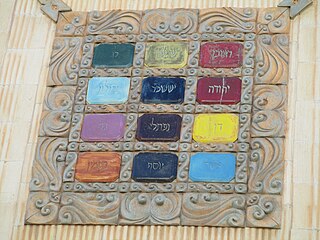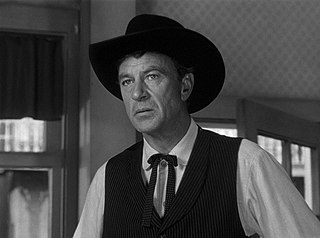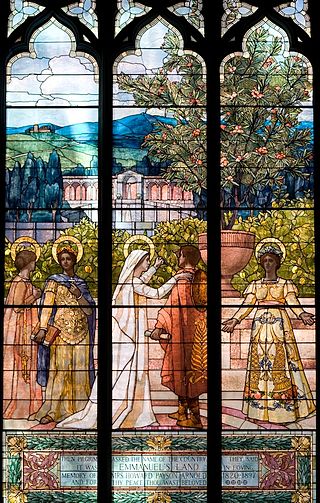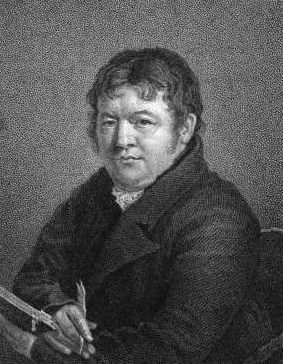
John Bunyan was an English writer and Puritan preacher. He is best remembered as the author of the Christian allegory The Pilgrim's Progress, which also became an influential literary model. In addition to The Pilgrim's Progress, Bunyan wrote nearly sixty titles, many of them expanded sermons.

Bunhill Fields is a former burial ground in central London, in the London Borough of Islington, just north of the City of London. What remains is about 1.6 hectares in extent and the bulk of the site is a public garden maintained by the City of London Corporation.

The Pilgrim's Progress from This World, to That Which Is to Come is a 1678 Christian allegory written by John Bunyan. It is regarded as one of the most significant works of theological fiction in English literature and a progenitor of the narrative aspect of Christian media. It has been translated into more than 200 languages and has never been out of print. It appeared in Dutch in 1681, in German in 1703 and in Swedish in 1727. The first North American edition was issued in 1681. It has also been cited as the first novel written in English. According to literary editor Robert McCrum, "there's no book in English, apart from the Bible, to equal Bunyan's masterpiece for the range of its readership, or its influence on writers as diverse as William Hogarth, C. S. Lewis, Nathaniel Hawthorne, Herman Melville, Charles Dickens, Louisa May Alcott, George Bernard Shaw, William Thackeray, Charlotte Bronte, Mark Twain, John Steinbeck and Enid Blyton. The words on which the hymn "To be a Pilgrim" is based, come from the novel.
The Newgate Calendar, subtitled The Malefactors' Bloody Register, was a popular collection of moralising stories about sin, crime, and criminals who commit them in England in the 18th and 19th centuries. Originally a monthly bulletin of executions, produced by the Keeper of Newgate Prison in London, the Calendar's title was appropriated by other publishers, who put out biographical chapbooks about notorious criminals such as Sawney Bean, Dick Turpin, John Wilkes and Moll Cutpurse.

In the Book of Ezekiel in the Hebrew Bible, New Jerusalem is Ezekiel's prophetic vision of a city centered on the rebuilt Holy Temple, the Third Temple, to be established in Jerusalem, which would be the capital of the Messianic Kingdom, the meeting place of the twelve tribes of Israel, during the Messianic era. The prophecy is recorded by Ezekiel as having been received on Yom Kippur of the year 3372 of the Hebrew calendar.

The priestly breastplate or breastpiece of judgment was a sacred breastplate worn by the High Priest of the Israelites, according to the Book of Exodus. In the biblical account, the breastplate is termed the breastplate of judgment, because the Urim and Thummim were placed upon it. These elements of the breastplate are said in the Exodus verse to carry the judgement of God concerning the Israelites at all times.

Lidlington is a small village and civil parish in Central Bedfordshire, England surrounded by farmland, in the Marston Vale. The hamlets of Boughton End and Thrupp End are also part of the parish.
A Harlot's Progress is a series of six paintings and engravings (1732) by the English artist William Hogarth. The series shows the story of a young woman, M. Hackabout, who arrives in London from the country and becomes a prostitute. The series was developed from the third image. After painting a prostitute in her boudoir in a garret on Drury Lane, Hogarth struck upon the idea of creating scenes from her earlier and later life. The title and allegory are reminiscent of John Bunyan's Pilgrim's Progress.

Heinz Memorial Chapel is a Pittsburgh History and Landmarks Foundation Historic Landmark and a contributing property to the Schenley Farms National Historic District on the campus of the University of Pittsburgh in Pittsburgh, Pennsylvania, United States.

The everyman is a stock character of fiction. An ordinary and humble character, the everyman is generally a protagonist whose benign conduct fosters the audience's identification with them.

George Howell was an English trade unionist and reform campaigner and a Lib-Lab politician, who sat in the House of Commons from 1885 to 1895.

The Lyric Theatre, also known as the Lyric Hammersmith, is a nonprofit theatre on Lyric Square, off King Street, Hammersmith, London.

St Michael Paternoster Royal is a church in the City of London. The original building, which was first recorded in the 13th century, was destroyed in the Great Fire of London in 1666. The church was rebuilt under the aegis of Sir Christopher Wren. However St Michael's was severely damaged during the London Blitz in the Second World War. It was restored between 1966 and 1968.
Events from the year 1678 in England.

The Wyvern Theatre in central Swindon, Wiltshire, England, opened in 1971. It is managed on behalf of Swindon Borough Council by Trafalgar Entertainment. The auditorium has 635 seats, all designed to be within 70 feet of the stage.

Frederic Crowninshield (1845–1918) was an American artist and author.

The lake of fire is a concept that appears in both the ancient Egyptian and Christian religions. In ancient Egypt, it appears as an obstacle on the journey through the underworld which can destroy or refresh the deceased. In Christianity, it is as a place of after-death punishment of the wicked. The phrase is used in five verses of the Book of Revelation. In the biblical context, the concept seems analogous to the Jewish Gehenna, or the more common concept of Hell. The image of the lake of fire was taken up by the early Christian Hippolytus of Rome in about the year 230 and has continued to be used by modern Christians.

Nathaniel Bentley, commonly known as Dirty Dick, was an 18th and 19th-century merchant who owned a hardware shop and warehouse in London. He was possibly an inspiration for Miss Havisham in Charles Dickens' Great Expectations, after he refused to wash following the death of his fiancée on their wedding day.

Dick Whittington and His Cat is the English folklore surrounding the real-life Richard Whittington, wealthy merchant and later Lord Mayor of London. The legend describes his rise from poverty-stricken childhood with the fortune he made through the sale of his cat to a rat-infested country. However, the real Whittington did not come from a poor family of common stock, and there is no compelling evidence supporting the stories about the cat, or even whether he owned one.

Joseph Ivimey (1773–1834) was an English Particular Baptist minister and historian.


















